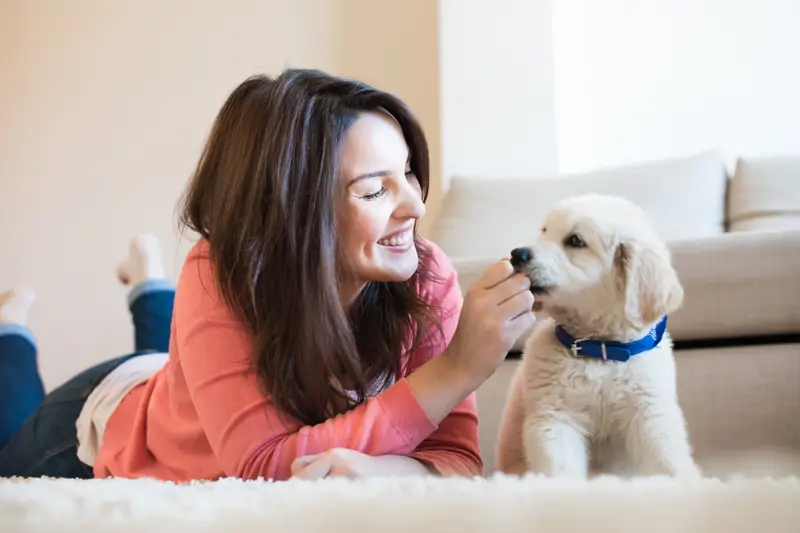TL;DR: A trial run with your pet sitter before your actual trip lets you test the arrangement, spot potential issues, and ensure your pet is comfortable—all before you’re stuck at an airport gate watching panicked texts roll in.
Your dog has memorized your work schedule down to the minute. Your cat knows exactly which counter you’ll set your keys on. And now you’re about to hand them off to a stranger while you’re 2,000 miles away? The anxiety is real—for you AND your pet.
That’s where a pet sitter trial run comes in. Think of it as a dress rehearsal before opening night, except the star of the show has four legs and zero interest in your travel plans.
What is a pet sitter trial run?
A pet sitter trial run is a paid, shorter booking with your sitter before your actual trip. Instead of hoping everything goes smoothly during your two-week vacation, you book them for a few hours, an overnight stay, or a day visit first.
The goal? See how your pet responds, how the sitter handles your specific requests, and whether your “my cat is super friendly” description holds up when a stranger walks through the door. (Spoiler: It often doesn’t. 😅)
This isn’t the same as a meet-and-greet
A meet-and-greet is the introduction—you’re there, the sitter is there, everyone’s on best behavior. A trial run is what happens when you’re NOT there and your pet has to accept this new reality without you as a buffer.
Why pet owners should do a trial run (even if it feels excessive)
You’ll discover deal-breakers before you’re locked in
Your pet’s anxiety around new people might be “manageable” when you’re home. When you’re gone? That’s a different story. A trial run reveals whether your dog stress-barks for six hours straight or if your cat refuses to eat when you’re not around.
Better to find out during a single overnight than halfway through your actual trip when you’re too far away to do anything about it.
Your sitter gets the real experience
Anyone can be charming during a 20-minute introduction. But can they locate the litter box at 2am? Do they know what “feed him a small dinner” actually means for your food-obsessed Lab? Will they notice when your usually chill cat is acting weird?
A trial run shows the sitter what they’re actually signing up for—and gives them a chance to back out if they realize your “easy” pet is actually a part-time chaos agent.
You can adjust expectations before the big trip
Maybe your instructions made sense in your head but confuse the sitter in practice. Maybe your dog needs a longer morning walk than you thought. Maybe your detailed feeding schedule is overcomplicated and stressing everyone out.
A trial run is your chance to revise, clarify, and fine-tune before the stakes are high.
Peace of mind is worth the extra cost
Knowing your pet and sitter have already done this once before makes your actual trip infinitely less stressful. You’re not white-knuckling your phone waiting for updates. You already know they’ve got this.
What a good pet sitter trial run looks like
Option 1: A few hours (for low-stakes situations)
Best for: Dogs who just need walks, cats with straightforward routines, or pets who are generally social and adaptable.
What happens: The sitter comes over while you’re at work or out for the afternoon. They follow your routine—feeding, playtime, potty breaks, whatever you’d normally do. You come home and debrief.
Cost expectation: Standard hourly or drop-in visit rate. Don’t expect free trial hours—professional sitters charge for their time, even if it’s a “test.”
Option 2: Overnight stay (for anxious or high-maintenance pets)
Best for: Pets with separation anxiety, specific bedtime routines, or medical needs that require overnight monitoring.
What happens: The sitter does a full 24 hours (or overnight into the next morning). They handle feeding, walks, bedtime, and the morning routine. You get a sense of how your pet sleeps, eats, and behaves without you there.
Cost expectation: A single night’s boarding rate. Some sitters offer a slight discount for trial runs, but most charge full price—and they should.
Option 3: Extended day visit (the middle ground)
Best for: Pets who don’t need overnight care but have longer or more complicated routines.
What happens: The sitter spends 6-8 hours with your pet during the day, handling multiple feeding times, medication, play sessions, or walks. It’s more involved than a drop-in but not a full overnight.
Cost expectation: Daycare or extended visit rate, typically higher than a standard drop-in.
How to set up a trial run with your pet sitter
1. Bring it up during the meet-and-greet
Don’t wait until after you’ve booked your vacation to suggest a trial. When you’re planning your meet-and-greet, mention it during your initial meeting: “I’d love to do a trial run before our trip in August. Does that work with your schedule?”
Most sitters appreciate this—it shows you’re serious, thoughtful, and not someone who’s going to panic-text them 47 times during the actual booking.
2. Book it far enough in advance
Schedule your trial run at least 2-4 weeks before your actual trip. This gives you time to:
– Find a different sitter if things don’t work out
– Adjust your pet’s routine if needed
– Let your pet have a “cool-down” period before the real deal
Booking a trial run the night before you leave defeats the purpose. You need time to process how it went.
3. Simulate real conditions
If your vacation involves evening arrivals and early morning departures, book the trial run to match that timing. If you’ll be gone for two weeks, an overnight trial gives you more insight than a two-hour visit.
The closer the trial mirrors your actual trip, the more useful it is.
4. Pay the full rate (yes, really)
Some pet owners balk at paying for a trial run. Here’s the thing: your sitter is working. They’re spending their time, energy, and expertise on your pet. Expecting them to do it for free—or at a discount—isn’t fair.
Professional sitters don’t do “free trial days” any more than your dentist does free trial cleanings. Respect their time by paying their standard rate.
5. Debrief after (with your sitter AND your pet)
Ask your sitter:
– How did my pet behave?
– Were my instructions clear?
– Is there anything I should change or add?
Observe your pet:
– Do they seem stressed or off?
– Did they eat normally?
– Are they acting clingy or distant toward you?
Use this feedback to tweak your plan before the real trip.
What to tell your pet sitter before the trial run
Your sitter needs more than “just feed him twice a day.” Give them the context they need to succeed.
Your pet’s actual personality (not the idealized version)
“He’s friendly” doesn’t prepare them for a dog who barks at the door for 10 minutes every time someone arrives. “She’s independent” doesn’t explain why your cat yowls if her wet food isn’t served at exactly 6pm.
Be honest. Your sitter can’t help if they don’t know what they’re walking into.
Specific behavioral triggers
Does your dog lose it when the mail carrier shows up? Does your cat hide for three hours if someone uses the wrong tone of voice? Does your rabbit freak out around loud noises?
Share these so your sitter isn’t blindsided.
What “normal” looks like for your pet
How much water does your dog usually drink? How often does your cat use the litter box? When does your pet typically nap?
Knowing the baseline helps your sitter spot when something’s off.
Emergency contacts and backup plans
Leave your vet’s number, a trusted neighbor’s contact, and instructions for what to do if your pet refuses to eat or seems sick.
Even in a trial run, things can go wrong. Your sitter needs to know who to call. The Petme Protection Plan offers additional security for situations that require immediate vet care.
Your actual travel plans (even for the trial)
Let them know you’ll be at work, at a friend’s house, or wherever you’re going during the trial. If something urgent comes up, they need to be able to reach you quickly.
Your inbox needs this
Subscribe to the Petme newsletter for weekly updates with pet care tips, tales, and member-only perks.

Questions to ask your pet sitter about trial runs
Before you book, clarify expectations so there are no surprises.
“Do you typically do trial runs with new clients?”
Some sitters always recommend them. Others only suggest them for anxious pets or complex routines. Knowing their usual approach helps you understand whether this is standard practice or an extra step.
“What’s your rate for a trial run?”
Most sitters charge their normal rate, but a few offer a slight discount for first-time bookings. Either way, get clarity upfront so there’s no awkwardness later.
“How long do you recommend for the trial?”
An experienced sitter can tell you whether your pet needs a full overnight or if a few hours will suffice. Trust their judgment—they’ve seen this scenario play out dozens of times.
“What happens if the trial doesn’t go well?”
Ask what their process is if your pet and the sitter aren’t a good match. Do they offer suggestions for other sitters? Will they try a second trial with adjusted instructions? Or do they simply part ways?
Knowing this ahead of time removes the guesswork if things don’t click.
“Do you provide updates during the trial?”
Some sitters send photos and check-ins. Others don’t unless there’s a problem. Clarify what level of communication you can expect so you’re not refreshing your phone every 10 minutes wondering if everything’s okay.
Why this matters for pet sitting
Trial runs aren’t just about protecting your vacation—they’re about building a relationship with a sitter you can trust long-term.
When you find a sitter who works well with your pet, you’re not starting from scratch every time you travel. You’ve already done the hard part. Your pet knows them. They know your pet. Future bookings are smoother, less stressful, and way more reliable.
A trial run is an investment in that relationship. It’s how you go from “hired a stranger off the internet” to “we have a sitter we trust completely.”
What to tell your pet sitter during trial planning
– Your pet’s quirks: “My dog takes 10 minutes to decide where to pee.”
– Household routines: “The mail arrives at 2pm and my cat freaks out every time.”
– What success looks like: “If he eats both meals and doesn’t destroy the couch, we’re good.”
– Emergency thresholds: “Call me if he refuses to eat. Otherwise, just send an update at the end.”
– How to reach you: “I’ll be at work but can step away if you need me.”
Questions to ask your sitter about the trial
– “What did you notice about my pet’s behavior?”
– “Were my instructions helpful or too detailed?”
– “Is there anything I should change before the real trip?”
– “Do you feel comfortable handling the full booking after this trial?”
– “Would you recommend another trial or are we good to go?”
When a trial run reveals a bad fit (and that’s okay)
Sometimes the trial shows you that this sitter isn’t the right match—and that’s exactly why you did it.
Maybe your dog didn’t warm up to them. Maybe the sitter realized your “low-maintenance” cat is actually high-maintenance and they’re not equipped for that. Maybe the communication felt off or the energy didn’t click.
None of this means you or the sitter failed. It just means you learned something valuable before your actual trip—and you have time to find someone else.
A trial run that doesn’t work out is still a success because it prevented a disaster during your vacation.
Trial runs through Petme: Testing with built-in trust
When you book a trial run through Petme, you’re not just testing a sitter—you’re trying out the entire support system that comes with the platform.
Every sitter on Petme is background-checked and reviewed by other pet owners. If something goes wrong during your trial (or your actual booking), the Petme Protection Plan has your back. And because Petme is a community-first platform, you’re connecting with sitters who genuinely care about your pet’s experience, not just the paycheck.
Find a sitter near you and book a trial run before your next trip. Your pet—and your stress levels—will thank you.
Frequently asked questions
How much should I pay for a pet sitter trial run?
Pay the sitter’s standard rate for whatever service you’re testing—whether it’s a drop-in visit, daycare, or overnight stay. Trial runs are paid bookings, not free auditions.
Is a meet-and-greet enough, or do I really need a trial run?
A meet-and-greet is essential, but it won’t show you how your pet behaves when you’re actually gone. If your pet has anxiety, medical needs, or you’re booking a long trip, a trial run is worth it. If you’re using a pet sitter for the first time, a trial becomes even more valuable.
What if my pet doesn’t warm up to the sitter during the trial?
That’s exactly what the trial is for. If it’s not a good fit, you have time to find someone else before your trip. It’s better to know now than when you’re already at the airport.
How long should a trial run be?
For straightforward pets, a few hours or a single drop-in visit works. For anxious pets or complex routines, an overnight stay gives you better insight.
Do most pet sitters offer trial runs?
Many do, especially for longer bookings or first-time clients. Not all sitters require them, but most are happy to accommodate if you request one.
Can I do multiple trial runs with different sitters?
Absolutely. If you’re unsure about your choice, trying a few sitters helps you find the best fit. Just be upfront with each sitter that you’re still deciding.
What happens if the trial run goes badly?
Debrief with the sitter to see if adjustments would help, or move on to a different sitter. A bad trial is still valuable information—it’s not a failure, it’s a filter.
Should I tip my sitter for a trial run?
If the trial goes well and you plan to book them for your trip, a tip is a nice gesture. It’s not required, but it reinforces that you value their work.
Conclusion: Trial runs turn strangers into trusted sitters
A pet sitter trial run isn’t paranoia—it’s preparation. It’s how you turn “I hope this works” into “I know this works.” And when you’re 3,000 miles away trying to enjoy a vacation, that confidence makes all the difference.
Before you leave your pet with someone new, give both of you the gift of a test run. Once you’ve walked through your home with your sitter, established clear house rules, and completed a successful trial, you’ll finally be able to board that plane without compulsively checking your phone.











